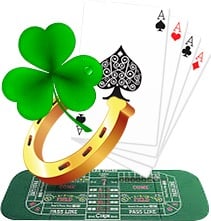Poker Math Made Easy

There are a lot of reasons that people play online poker. Maybe you play for the challenge or in hopes of honing your skills; maybe it’s just a way to relax after work. No matter what draws you to the game, everybody wants to win money. You will always depend on your skill (and a bit of luck) to find success, but you can put the odds in your favour by playing in the fishiest poker site you can find – the one that has the most novice players that are essentially throwing their money away. These kinds of easy poker rooms may be a hard to find if you don’t know what to look for, so we’ve gone ahead and compiled a listing of the best easy poker sites. Playing at these recommended poker sites is the best way to give yourself a chance to come out ahead in the long run.
Unlike most casino games, dumb luck won't get you very far in poker. To succeed at this game of skill, you'll need knowledge, discipline, and plenty of practice. Your brain will need to fire on all cylinders if you hope to outplay and outsmart your opponents. Whether you play for fun or aim to take home stacks of banknotes, you'll need to understand the math that lies at the centre of every poker play.
The good news is poker math doesn't have to be complicated, even if you failed high school maths. You won't be dealing with abstract concepts that never see the light of day here. Poker math is easy to apply and will give you tangible results. Take the time to learn the concepts and start succeeding at the tables. The best part is you can easily refer to this guide while you play. It's much easier to ace your exam when you're allowed to bring a cheat sheet.
What Are Odds?
Probabilities or odds are simply the likelihood of an event happening. Imagine you have ten dice in your pocket. Five of them are red, three are blue, and two are yellow in colour. The probability or likelihood of reaching into your pocket and pulling out a blue die is 3 in 10 or 30%. Likewise the probability of pulling out a red die is 50% and the probability of drawing a yellow die is 20%. Note that all the possibilities add up to 100%. Keep in mind that these probabilities are only valid when all 10 dices are still in your pocket. Once you remove one, the odds will shift. This will become apparent once we start speaking in terms of cards.
To speed up the learning process, we recommend reguarly using our free online poker odds calculator
Understanding A Deck Of Cards
A deck of cards is more complicated that a pocketful of dice. In Texas Hold'em and most other forms of poker, you'll be playing with a 52-card deck. Every card has a suit (clubs, spades, diamonds, or hearts) and one of thirteen numbered ranks or faces (A, 2, 3, 4, 5, 6, 7, 8, 9, 10, jack, queen, king). Imagine that you pull out one card at random from a full deck. Here are some probabilities to consider:
- Probability of drawing a queen: 4 in 52 = 7.69%
- Probability of drawing a diamond: 13 in 52 = 25%
- Probability of drawing a face card: 12 in 52 = 23.07%
- Probability of drawing the ace of spades: 1 in 52 = 1.92%
You can easily derive those percentages by dividing the first number by the second number on your calculator. Ultimately you'll refer to poker odds tables, which we'll get to shortly.
There's more to poker than pulling a single card from a full deck. Those odds are dynamic and they'll change as cards are dealt from the deck. Looking back at the first example where you've already pulled out a queen. If you were to draw another card from the deck, you would only be drawing from a pool of 51 cards. Let's take a look at the new probabilities, assuming that the first card was a queen of spades:
- Probability of drawing a queen: 3 in 51 = 5.77%
- Probability of drawing a diamond: 13 in 51 = 25.49%
- Probability of drawing a face card: 11 in 51 = 21.57%
- Probability of drawing the ace of spades: 1 in 51 = 1.96%
Those are fairly basic probabilities. What you really want to know is the likelihood of drawing a queen as your first card and a queen as your second card. You'll need to multiply those two percentages together:
- (4/52) X (3/ 51) = 0.45 %
That means you would have to play 222 hands on average to see a pair of queens.
Probabilities At The Tables
The above examples illustrate how probabilities work but you won't be playing poker alone. Your opponents will be drawing cards from the same deck as you. You'll know your cards and you'll be able to see the community cards yet your opponents' cards will be unknown. Luckily you can make use of various poker probability tables or calculators that tell you likelihood of your opponent having a certain hand based on what you hold. If you've ever watched poker on TV, you'll know they display the odds of each player winning. The odds are dynamic and different preflop, after the flop, and at the turn.

Outs And Odds
Probabilities are only one piece of the equation. You'll also need to know how many cards can improve your hand after the flop or the turn. These possible cards are known as outs. Imagine you are playing Texas Hold'em.
- You hold a J of diamonds and 8 of diamonds.
- After the turn the community cards are A of diamonds, 7 of clubs, 5 of hearts, 3 of diamonds.
- You don't know what your opponent holds.
- If you want to win, you'll need to land a diamond at the river.
So how many cards can improve your hand? Consider that there are 13 diamonds in a deck. You already have two of them and another two are on the table.
- 13 (diamonds in the deck) - 2 (diamonds you hold) - 2 (community diamonds) = 9 diamonds in the deck
Those 9 diamonds are your outs and you'll need them to calculate your odds to make an informed decision.
The next step is to calculate how many unknown cards are still in play. Let's recap what we know:
- You are playing with a 52 card deck.
- You have 2 pocket cards.
- There are 4 visible cards on the table.
- There are 46 unseen cards, including your opponent's cards.
Now we need to pick sides by separating the losers and winners. In order to complete your flush on the river you'll need to land one of those 9 diamonds among the 46 unseen cards. But what if you land one of the 37 non-diamond cards? What's the likelihood of that?
- The odds of getting a flush are 9 (diamond cards) / 37 (non-diamond cards) = 24.32%. or 37:9 odds
That's slightly worse than a 1 in 4 chance, which isn't terrible. Whether you should raise, call, or fold is another matter entirely.
Pot Odds
Now that you know the odds of landing your card, you need to compare this with the odds of winning the pot. Consider the following using the example above:
- The pot has $300 in it.
- Your opponent raises $50, bringing the total pot value to $350.
- You'll need to call $50 to win $350.
- In this example your pot odds $350/$50 or 7:1.
In order to know if calling is worth your while, you'll need to compare your pot odds with your card odds. If your pot odds are better than your card odds, then it's statistically worth trying your luck.
- In this scenario 7:1 is better than 37:9 (or roughly 4:1), which means you should call.
You don't actually need to calculate these pot odds. You can take advantage of any of the handy tables or calculators that do all the work for you.
Implied Odds
While pot odds can help you decide whether to stay in the game, implied odds tell you how much you need to win to make it all worthwhile.
Returning to the example above where you are trying to complete your diamond flush
- This time your opponent wagers $300 into a $300 pot.
- You'll need to call $300 to make $600.
- The odds of making your flush are 37:9 or 4.11:1.
- The pot odds are 2:1.
To calculate the implied odd subtract the pot odds from the odds of landing your hand:
- The odds of drawing a flush (4.11:1) - the pot odds (2:1) = 2.11:1
Now that you know your implied odds are 2.11:1 you can see how much more money your opponent will need to pony up throughout the hand so that you can at least break even. In this case you would multiply 2.11 by the original $300 bet. That means you'll need an additional $633, which definitely puts things in perspective.
Reverse Implied Odds
Reverse implied odds (RIO) are arguably more valuable than the implied odds we just discussed. RIO will tell you how much you stand to lose if you land the cards you're after and your opponent still beats you.
Imagine you have a 3 of diamonds and 2 of diamonds with a 5 of hearts, 6 of spades, and 7 of hearts on the board. You're obviously hoping to complete your straight of the turn with a 4. The real question is whether your opponent will have a superior straight if that 4 shows up or a flush for that matter. Reverse implied odds are tricky to calculate but you should know that they are inversely proportional to the implied odds. As a rule of thumb if your pot odds are poor, and your RIO are high, the right move is to bow out.
Poker Variance
It's important to realise that any calculations you make in poker are only statistically significant over time. If you look at a small sample of hands, you may feel like all your calculations are off. The fact is the truth does play out over the long haul. Don't abandon poker math or the game itself if you don't start winning from the get go. In the long haul there is no better way to play. Statisticians use the term variance to describe the difference between your current results and what happens over the long haul.
Universities offer complete courses on variance. It's best to acknowledge its existence and know that over time the good and bad will equal each other out. You can calculate your variance by keep tabs on your performance during each session.
Imagine you play five one hour sessions of Omaha poker and win $10 in your 1st session, win $20 in your 2nd session, lose $5 in your 3rd session, win $17 in your 4th session, and lose $13 in your fifth session. That's an average win of $5.80.
Your variance is how much you deviate from this average. In the example above your deviations would be 4.2 in the 1st session, 14.2 in the second, 10.8 in the third, 11.2 in the fourth, and 18.8 in the fifth. If you square each of these deviations, add them together, divide by the number of sessions, and finally take the square root of the total, you'll know how far a typical session will deviate from your average $5.80 win.
Dealing With Variance
You can safeguard against variance by having a large enough bankroll. Decent bankroll management can make up for the deviation no matter how long and severe. Breakup your bankroll and don't overextend yourself. If you are reading this, you are likely new to the game or brushing up on your skills. Take advantage of free games and freerolls to test drive these lessons. Take advantage of all the calculators and tables while you play. If you use them regularly, they'll quickly become etched in your brains. Not only will you know them like the back of your hand, you'll probably be able to write your own poker math tutorials for the masses.
Some online poker sites offer bad beat jackpot tables that reward players who lose with outstanding hands. These are particularly fun since they provide a lucrative safety net to a specific kind of variance.






